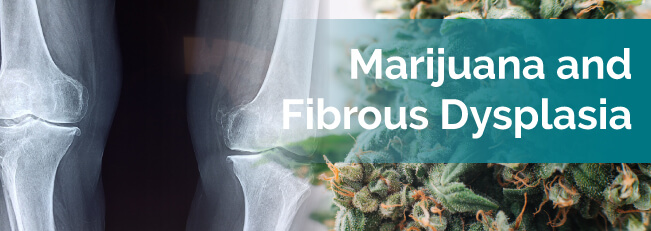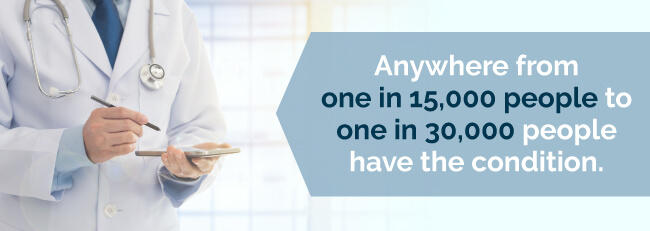
Fibrous dysplasia is a gene mutation causing abnormal bone growth, which may lead to deformities or fractures. The condition has no cure and can be very painful. Using medical cannabis for fibrous dysplasia may help ease the symptoms to minimize the impact it has on your daily life.
Fibrous dysplasia is a congenital, benign condition that causes fibrous tissue and immature bone to replace normal bone. The abnormal growth is sometimes described as scar-like lesions or benign tumors. The fibrous tissue is much softer than normal, healthy bone tissue. That abnormal development causes weakness in the bone, which may increase the risk of fractures or cause the bone to be deformed.
The monostotic type of fibrous dysplasia affects just one bone in the body. This is the most common form of the condition. The polyostotic version of fibrous dysplasia affects multiple bones, but is less common.
Because symptoms vary in severity — some people’s symptoms are so mild they’re unaware they have the condition — it’s difficult to understand how many people actually have fibrous dysplasia. Estimates suggest rates anywhere from one in 15,000 people to one in 30,000 people have the condition. It affects people of all races, and it affects males and females equally.

Fibrous dysplasia is a rare condition most often diagnosed in children and young adults. It can affect any bone in the body. However, it most commonly occurs in the skull and face, femur, tibia, humerus, pelvis and ribs. And, although the condition can affect multiple bones at once, it cannot spread from one bone to another. The condition is caused by a defective gene in the cells that form bone, as well as other affected tissues. That gene mutation happens after conception. Fibrous dysplasia is not inherited, so parents do not pass it on to children. The specific cause of the gene mutation is unknown.
Fibrous dysplasia sometimes occurs as part of a condition called McCune-Albright syndrome. The syndrome typically involves the polyostotic type of fibrous dysplasia, early puberty, endocrine issues and changes in skin pigment that typically cause brown spots.
Patients with fibrous dysplasia may show few, if any, signs of the condition, especially in mild cases. This means many people may go undiagnosed, as the condition never becomes severe enough to produce symptoms. The symptoms often increase in severity as the condition itself increases in severity. For example, someone with a minor case might have only slight pain, while a person with severe fibrous dysplasia might experience very intense pain.
One possible symptom of fibrous dysplasia is a painless enlargement of the bone affected by the condition. A fracture in an extremity can also lead to the diagnosis of the condition. Other possible symptoms include bone pain, bone deformities and nerve entrapment. However, the condition presents in various ways and in various levels of severity, so those symptoms may also vary.
Symptoms can vary depending on the bones affected by the condition. For example, fibrous dysplasia affecting the craniofacial skeleton tends to impact the maxilla or frontal bones, resulting in an asymmetrical appearance in the face. In some cases, the condition can affect vision, hearing, cranial nerve function, speech and eating.
Like most symptoms, the pain associated with fibrous dysplasia often depends on the severity of lesions. The pain occurs with the growth and expansion of the fibrous tissue. Patients often experience dull aches in the affected bones. The aching may increase in severity with physical activity, and may worsen over time. Patients with fibrous dysplasia in the legs or pelvic bones tend to have a higher risk of pain, since those bones are weight-bearing. The condition may also cause difficulty walking or other mobility issues when it affects the legs.
In some cases, some complications may arise due to the condition. If the condition affects the bones surrounding nerves to the eyes and ears, vision and hearing loss may occur. This is rare, but it is a possible complication. Patients with fibrous dysplasia in the legs or pelvic bones may develop arthritis in the joints if those bones become deformed. While fibrous dysplasia is a benign condition, in some rare cases, patients may develop cancer in the affected bones, primarily if the patient previously underwent radiation therapy. Only about 1 percent of patients develop cancer due to the condition.
The risk for bone fractures can also affect the patient’s everyday activities. For example, participating in high-risk activities, such as contact sports, is dangerous due to the increased risk. For other people, the pain and stiffness associated with the disease may limit mobility and interfere with regular activities.
Patients with fibrous dysplasia are born with the condition, although it is not often discovered until later in childhood. Some patients aren’t diagnosed until their teen years. In some cases, some of the symptoms appear at an earlier age, although the diagnosis is not made immediately. The type of fibrous dysplasia can affect the timing of diagnosis. When the condition affects only one bone, diagnosis often occurs in adolescents or young adults. When the condition affects multiple bones, symptoms typically appear before age 10. The earlier diagnosis typically occurs due to this type of the disease being more severe.
In some cases, the symptoms of fibrous dysplasia may decrease as the patient gets older. Some patients experience a decrease in problems associated with the condition after puberty. This is particularly true if the condition affects the arms and legs. Other patients continue having problems well beyond puberty. Some patients don’t even receive a diagnosis until reaching adulthood. The specific symptoms and how they progress or improve vary significantly from patient to patient.
A diagnosis typically involves an examination of the skull and body. Additional testing used to track changes in the craniofacial skeleton include CT scans, X-rays and MRIs. The condition can be diagnosed by a characteristic appearance visible through x-rays. Bone biopsies can also help confirm a fibrous dysplasia diagnosis. In some mild cases, a doctor could discover the condition accidentally while performing an X-ray for another reason.
Fibrous dysplasia has no cure. The course of treatment depends primarily on the severity of the condition and focuses on relieving the symptoms of the condition. A team of physicians works with the patient, thoroughly evaluating and tracking the condition. In mild cases, the doctor simply monitors the situation with occasional X-rays and exams.
There is no current pharmaceutical treatment for fibrous dysplasia. However, there are several surgical practices available for patients who have a more severe form of the condition.

Surgery is often used to treat fibrous dysplasia in the following ways:
In some cases, removing the lesions in the bone requires the surgeon to replace the removed material with a bone graft. The bone tissue can come from another part of the body or from a deceased donor. Other surgeries for the condition involve placing metal plates, rods or screws in the bone to stabilize it or secure the graft to the bone.
Some adult patients may experience chronic pain due to fibrous dysplasia. There are several FDA-approved medications, known as bisphosphonates, which can work to alleviate symptoms of pain associated with fibrous dysplasia. Additionally, physical activity, with the permission of primary healthcare physician, calcium, phosphorus and vitamin D intake can help to treat the condition.
Pain is a primary concern for patients with fibrous dysplasia. The pain can be an ache in the bones, throbbing or radiating pain. For chronic pain management, achy bones and weakness, medical-grade marijuana can provide immediate relief for patients with fibrous dysplasia.

Both THC and CBD, two cannabinoids present in various strains of medication marijuana, help decrease both acute and chronic pain. The cannabinoids activate CB1 and CB2 receptors, which can help manage pain levels. In some cases, medical marijuana for fibrous dysplasia can treat pain that doesn’t respond to traditional pain management options.
Stiffness is another possible symptom associated with the condition. Surgical procedures to treat the condition may contribute to the stiffness. Marijuana can help reduce stiffness, which increases the ability to move easily. Reduced pain and stiffness can help patients live a more normal life.
Research on marijuana and fibrous dysplasia is very limited for two primary reasons. First, the condition is rare, so it doesn’t catch the attention of researchers like diseases with higher incidences. Second, marijuana is considered a Schedule 1 drug, and researchers often have limited access to it, making research difficult.
Despite the lack of research, patients with fibrous dysplasia may find relief from pain by using cannabis. In addition to the pain relief, marijuana may help improve bone health and could support healing after fractures. Several cannabinoids, including CBD, CBC and CBG, may stimulate bone growth, which can help patients with bone weakness due to fibrous dysplasia.
If you or someone you know suffers from fibrous dysplasia, you may find relief from the symptoms, particularly pain and stiffness, by using cannabis. Scientific research on cannabis and fibrous dysplasia may be limited, but doing your own experimentation with various strains can help you find the right mix of relief from symptoms.
The strain of marijuana you use depends on the other effects you want. Sativa-dominant strains of marijuana provide effective pain relief for fibrous dysplasia. These strains also tend to have an energizing effect. This is ideal if you’re using the medical marijuana during the day and want to stay alert or have more energy.
Indica-dominant strains of marijuana are also effective in treating the pain. These strains of marijuana tend to have a sedating effect that helps you sleep. Use these strains when the pain from fibrous dysplasia interrupts your regular sleep routine. The combination of the pain relief and the sedating feeling may help you fall asleep and stay asleep longer without being awoken due to pain.
Once you choose a strain of marijuana, you need to choose a method of ingesting the cannabis. The age of the patient is a consideration when choosing the ingestion method. Smoking is most often associated with marijuana use, but since fibrous dysplasia primarily affects children, smoking is not a good option. Even in older patients, smoking is not always ideal, as it can cause breathing and lung issues.
Here are other ingestion options to consider when treating fibrous dysplasia with marijuana:

Many patients who use medical marijuana to treat conditions use a combination of ingestion methods. You might apply a topical product for immediate relief at the source of the pain, and use an edible for longer-term relief. You might also use different strains of marijuana at different times based on your needs and activities. For instance, you could vaporize a Sativa-dominant strain in the morning for quick relief with an uplifting effect. At night, Indica-dominant strains provide the pain relief with sleepiness for better rest.
An experienced marijuana doctor can be extremely helpful in deciding which strains to use at different times. The doctor will review your specific case and medical history to help you find the right options. Keep in mind that it sometimes takes some experimentation with different strains to find a good match for you.
Cannabis causes very few side effects. Most of the effects are minor and go away as soon as the marijuana wears off. Some of the effects of using marijuana can actually provide additional relief or don’t cause a negative impact on the user.
Some of the potential side effects include:
Medical marijuana helps many people find pain relief they haven’t found from traditional pain relief options. Since pain is a primary side effect of fibrous dysplasia, cannabis can be an effective option for patients with the condition. If you or a loved one is suffering from fibrous dysplasia, medical marijuana could be an effective treatment option for the pain and stiffness you experience. We can connect you to hundreds of qualified, experienced marijuana doctors across the U.S. in legal marijuana states to ensure you remain in compliance with your state’s regulations. Schedule an appointment today to start improving your quality of life.
For more information about how cannabis can be used to treat Fibrous Dysplasia, check out our resources:
Find A Doctor Find A Dispensary